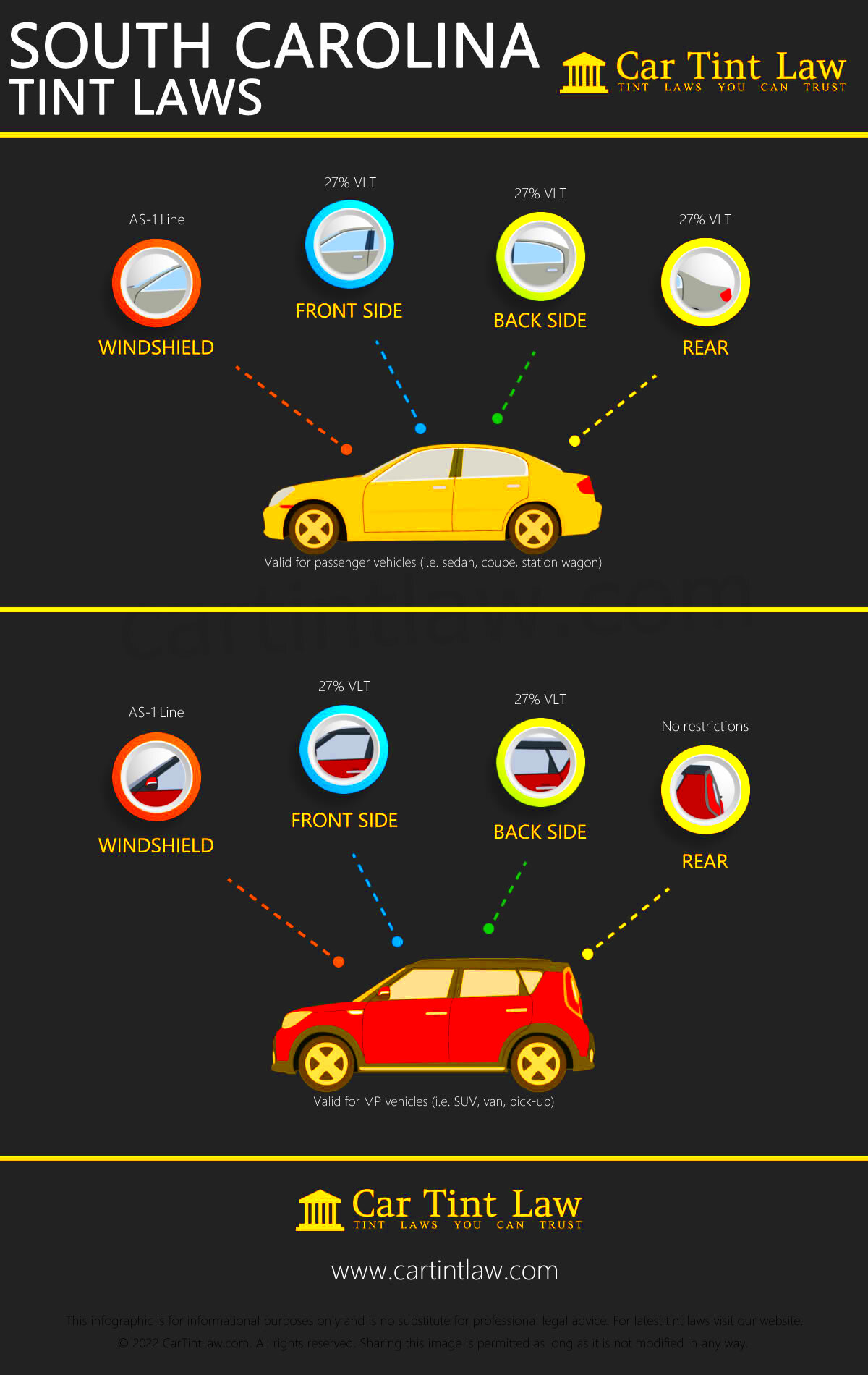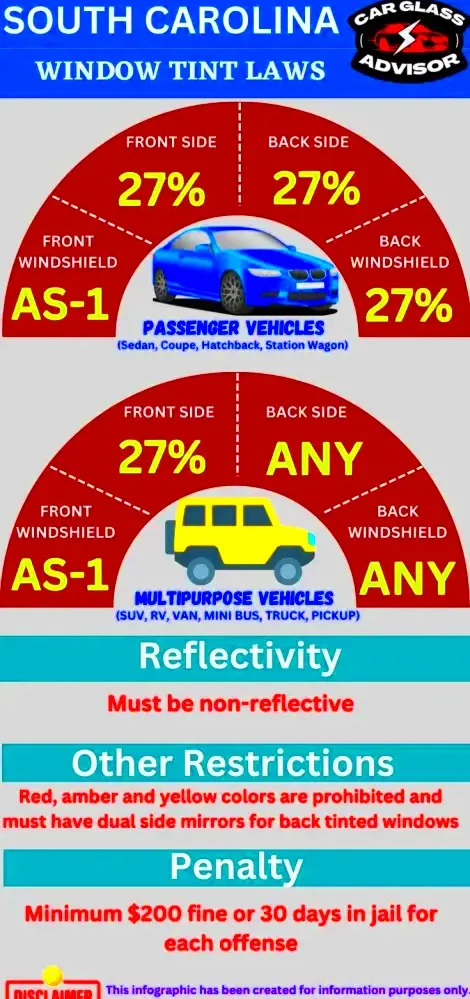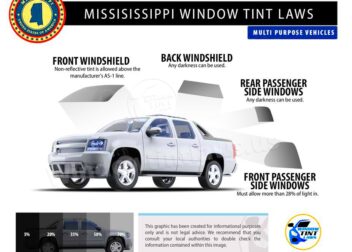South Carolina Window Tint Laws and What They Mean for Drivers
Window tinting can enhance your car’s appearance, provide privacy, and protect you from harmful UV rays. However, South Carolina has specific regulations governing how much tint you can have on your vehicle’s windows. Understanding these laws is essential to avoid fines and ensure your car remains road-legal. By following these rules, you can enjoy the benefits of window tinting without breaking the law.
How Dark Can Your Window Tint Be in South Carolina?

In South Carolina, the darkness of your window tint is measured by Visible Light Transmission (VLT). This percentage determines how much light passes through the window and tint film. The rules vary depending on whether you have a sedan, SUV, or van. Here’s a quick overview:
- Sedans: Front side windows must allow more than 27% of light in, and the back side windows can have the same limit. The rear window can also follow this 27% rule.
- SUVs and Vans: The front side windows must allow more than 27% of light in, but the back side and rear windows can have any darkness level.
Keeping these regulations in mind ensures you don’t exceed the legal limit and risk being penalized during inspections or traffic stops.
What Are the Visible Light Transmission (VLT) Requirements?
The VLT percentage is crucial for determining how much tint you can apply. VLT refers to the amount of visible light that passes through both the tint film and the window itself. Here’s how it works:
| Type of Vehicle | Front Side Windows | Back Side Windows | Rear Window |
|---|---|---|---|
| Sedan | 27% or more | 27% or more | 27% or more |
| SUV/Van | 27% or more | Any darkness | Any darkness |
It’s important to note that the percentage applies to combined tint and glass, meaning factory-tinted windows may already be close to the limit. Installing a darker film could push your car over the legal threshold.
Which Windows Are Affected by the Tint Laws?
South Carolina’s window tint laws don’t apply to every window in the same way. Different rules govern the front, back, and rear windows of a vehicle. This ensures that visibility for drivers and law enforcement remains safe while allowing some flexibility for privacy and comfort. Here’s a breakdown of which windows are affected:
- Front Side Windows: These windows must comply with the most stringent rules. They must allow at least 27% of light to pass through for all vehicles, regardless of type. This ensures that drivers maintain a clear view and that police officers can see inside the vehicle during traffic stops.
- Back Side Windows: For sedans, these must also allow at least 27% of light in. However, SUVs and vans have more leeway, allowing any level of darkness on these windows.
- Rear Window: The rear window follows the same rules as the back side windows. Sedans must keep it at 27% or more, while SUVs and vans can use any tint darkness.
Windshields are generally not allowed to have tint except for a non-reflective strip along the top, typically no more than a few inches deep. These laws ensure drivers can maintain clear visibility without compromising their safety.
Medical Exemptions for Window Tint in South Carolina
For individuals with specific medical conditions, South Carolina offers exemptions to the standard window tint laws. These exemptions allow darker tints to protect drivers and passengers from sunlight, which may aggravate certain health issues. Some of the conditions that might qualify include:
- Skin conditions like lupus or melanoma
- Albinism, which reduces the skin’s ability to block UV rays
- Photosensitivity caused by medications or medical treatments
To apply for a medical exemption, you must provide a signed statement from a licensed physician or optometrist, explaining why you require additional protection from sunlight. Once approved, you can use darker window tints on your vehicle, but you must carry the exemption documentation at all times to present to law enforcement if necessary.
This exemption helps people with medical needs maintain their safety while driving in South Carolina’s bright sun, without facing fines for non-compliant tint levels.
Penalties for Violating South Carolina’s Window Tint Laws
Failing to comply with South Carolina’s window tint laws can lead to a variety of penalties. These consequences are designed to encourage adherence to the regulations and maintain safety on the roads. Here’s what you can expect if your window tint violates the legal limits:
- Fines: Drivers caught with illegal window tinting may face fines. These fines typically range from $100 to $200, depending on the severity of the violation and the number of offenses.
- Fix-It Tickets: In some cases, law enforcement may issue a “fix-it ticket,” which gives you a specific period to remove or adjust the tint to meet legal standards. Once the changes are made, you may need to present your vehicle for inspection.
- Vehicle Inspection Failure: During routine vehicle inspections, illegal tints can cause your car to fail. This could result in additional costs and the need to remove or adjust the tint before re-inspection.
Repeated violations can lead to more severe penalties, including higher fines or legal action. It’s essential to ensure your tint complies with South Carolina’s laws to avoid unnecessary complications.
How to Ensure Your Tint Complies with State Laws
Making sure your window tint is within South Carolina’s legal limits is crucial for avoiding fines and ensuring your car remains road-legal. There are a few steps you can take to ensure compliance:
- Check the VLT Percentage: Before applying tint, confirm the Visible Light Transmission (VLT) percentage of the film. South Carolina requires at least 27% of light to pass through the front side windows of all vehicles. For back and rear windows, the rules vary based on vehicle type.
- Consult with a Professional Installer: A reliable tint installation service will be familiar with state laws and can recommend the appropriate tint for your vehicle. They’ll also ensure the installation is done correctly to avoid issues with uneven application or bubbles.
- Use a Tint Meter: A tint meter measures how much light passes through your windows. You can purchase a meter or have your car’s tint tested at an inspection station to ensure it meets legal standards.
- Be Aware of Pre-Tinted Windows: Many cars come with factory-tinted windows that already reduce light transmission. If you add aftermarket tint, the combined darkness may exceed legal limits, so it’s important to consider this when selecting new tint.
By following these steps, you can make sure your car’s tint remains compliant with South Carolina’s window tint laws, helping you avoid fines and penalties.
Frequently Asked Questions about South Carolina Window Tint Laws
1. Can I tint my windshield in South Carolina?
No, tinting your windshield is generally prohibited, except for a non-reflective strip along the top, which cannot extend more than a few inches. This strip is usually allowed for sun protection without obstructing your view of the road.
2. Are there different tint laws for SUVs and sedans?
Yes, the rules differ depending on the type of vehicle. For example, SUVs and vans can have darker tint on the rear and back side windows, while sedans must keep all windows at a 27% VLT or higher.
3. Do medical exemptions allow for darker tints?
Yes, individuals with certain medical conditions can apply for exemptions that allow for darker window tints. These exemptions require documentation from a licensed physician or optometrist and must be kept in the vehicle at all times.
4. What happens if my tint doesn’t meet the legal requirements?
If your window tint exceeds legal limits, you may face fines or receive a “fix-it ticket,” requiring you to adjust the tint. In some cases, your vehicle may also fail inspection until the tint complies with state laws.
Conclusion on Staying Within the Legal Limit
Staying within South Carolina’s legal window tint limits is not just about avoiding fines—it’s about ensuring safety on the road. By adhering to the state’s regulations, you can enjoy the comfort and protection of tinted windows while maintaining proper visibility and following the law. Be sure to regularly check your tint’s compliance, especially if you purchase a used vehicle or have had your windows tinted for a while.
If you’re ever unsure about your tint’s legality, consulting a professional installer or testing your windows with a tint meter can provide peace of mind. Remember, following the rules helps protect both you and other drivers on the road.


